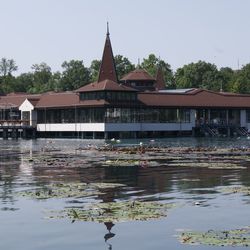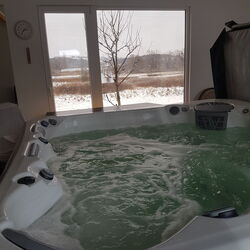

A pantry experience from Zala
Drying herbs on the terrace, ripe tomatoes in the greenhouse, the scent of fresh jam in the kitchen — Dédi nyomában Biogarden started as a self-sufficiency project, a lifestyle choice rooted in a close connection to nature. It’s a small homestead where everything is made from what the garden yields, just a little more than you would preserve for yourself. And what will you find on the pantry shelves? Vegetable spreads, pickled vegetables, mixed salads, jams, and syrups for sure.
Inspired by tradition
Szabina’s family comes from the Bakony region. After living in Pilis, she moved to Zala County in 2022, choosing a new path with gardening at its heart — cultivating 4,000 m² of land. Initially experimenting with bio-intensive vegetable farming, she soon realized her true calling was not large-scale production, but crafting small batches of homestead delicacies with care and joy.The greenhouse, crop rotation, chickens, runner ducks, and composting all reflect her mindful approach to farming.
Bio-intensive, chemical-free farming
Every section of Szabina’s garden serves a purpose, the result of thoughtful planning. Fixed garden beds and a greenhouse are the core, where she practices regular crop rotation, enriches the soil with compost and mulch, and grows most plants from her own collected seeds, adapted to their environment. She uses well water for irrigation.
For pest and disease management, she relies on natural methods: companion planting, insect netting, and biological solutions. Ducks and chickens happily assist by controlling snails and pests — no chemicals involved.
Open the pantry & explore
Szabina’s products include syrups, jams, dried herbs, pickles, and vegetable spreads — all made in small quantities, available seasonally and in varied selection. The charm of Dédi nyomában Biogarden lies in its simplicity: only as much is produced as the garden and nature provide — and only what Szabina herself enjoys making.
While the farm’s name evokes old times, Szabina incorporates modern techniques too. She uses a canning machine to preserve syrups and pickles, ensuring shelf life and efficiency. Jams are made with sugar and gelling agents, while syrups and pickles are preserved without chemical additives, using the canning method.
Herbs like lemon balm, mint, lavender, rose, and violet are handpicked, dried, and crushed. Vegetable spreads, pestos, and tomato sauces are always processed fresh — and they tend to sell out quickly!
Product highlights
Vegetable spread
Dédi nyomában Biogarden’s vegetable spreads are always made from whatever the garden currently yields — zucchini, tomatoes, peppers, or eggplant. What’s guaranteed in every jar is the essence of sun-ripened vegetables. Szabina grows her vegetables chemical-free, hand-harvests, chops, steams, or oven-roasts them, seasons to taste, and blends into a creamy, spreadable texture.
Flavors change with the seasons and what’s available in the pantry: wild garlic, garlic, fresh herbs, or a mildly spicy kick. Each batch is unique and delicious. The spreads contain no preservatives or additives and are often produced in very limited quantities — sometimes just a few jars.
Where to buy
More information & Contact:
About 10,000 years ago, rapid climate warming triggered a cascade of natural responses: torrential floods, landslides, and intense rock weathering. The landscape we walk on today was not shaped over mere centuries, but by the dramatic forces of climate and water, working together. Did you know that the Zala Valley floor is made up of sediments deposited by a kind of "river of time"? Discover how the Earth’s surface became one of the most sensitive indicators of climate change. We often associate climate change with contemporary issues, but Earth’s climate has shifted many times throughout its history — sometimes quite rapidly. Within large-scale climatic cycles, alternating periods of warming and cooling have long been part of the planet’s natural rhythm. A change in climate sets off a chain reaction of environmental processes. It’s not just animals and plants that respond — so does the landscape itself. Around 10,000 years ago, as the climate warmed significantly, rainfall became more intense. More rain meant more erosion: stormwater began washing away sediment from hills and valleys into riverbeds. The rivers, now carrying more water and more sediment, flooded more often and spread these materials across the landscape. This had a major impact on topography: the land surface became more fragmented and dynamic. Warming temperatures also sped up chemical and physical weathering, breaking down bedrock and helping fertile soil layers to develop. Today, in many areas of the region, the lower slopes and valley edges are coated with sediment — debris washed down from higher ground, largely within the last 10,000–20,000 years. In the Zala Valley, for instance, these deposits have spread so far that they now reach the center of the valley floor. The original bedrock source of these sediments varies: in Zala, it’s typically Pannonian sand (Somló Formation), while in the Keszthely Hills, marine-origin carbonates dominate — mostly dolomite, with some limestone. These sediments now appear as fine gravel, pebbles, or coarse sand, quietly recording the environmental changes of the recent past.
Climate Change: Not Just a Modern Phenomenon
When Climate Changes, Everything Reacts
Shaping the Terrain
In short, natural geological processes that had long been underway suddenly accelerated — and reshaped the surface of the land.Young Sediments at the Base of the Slopes












